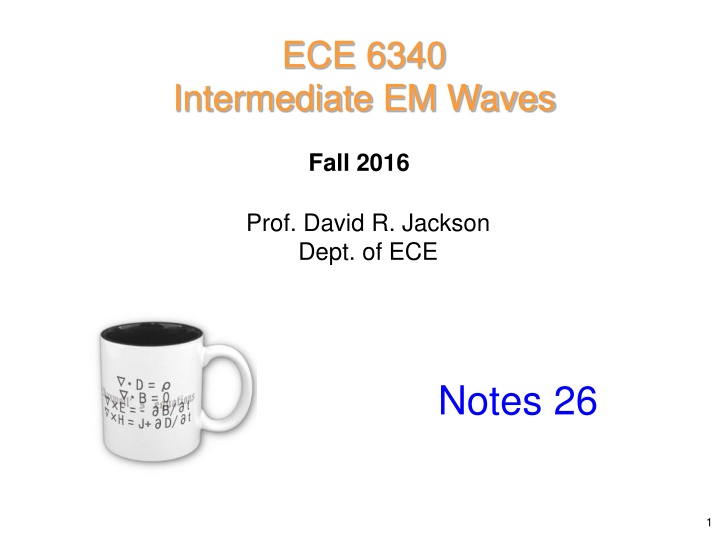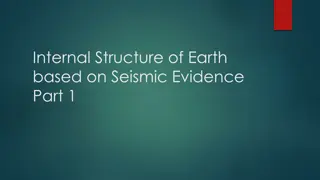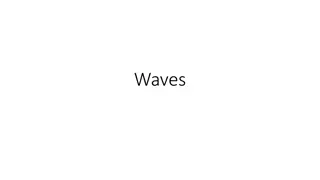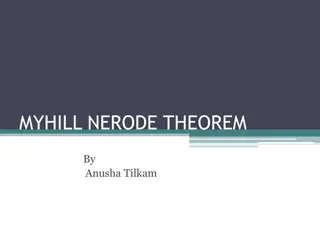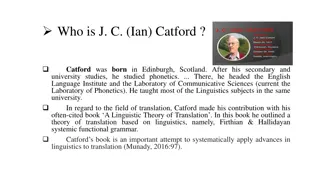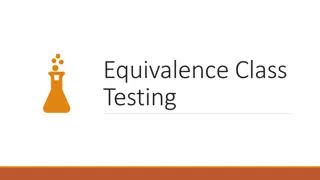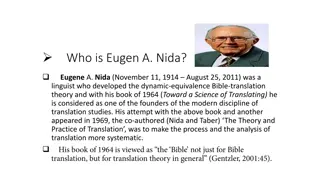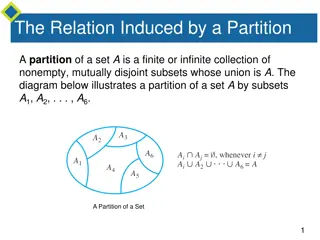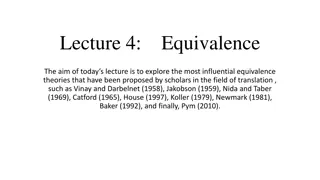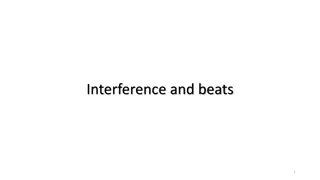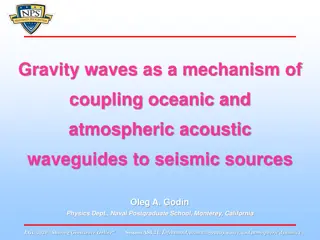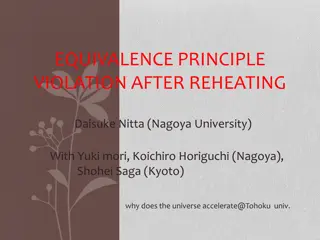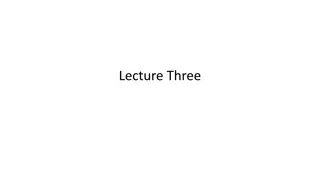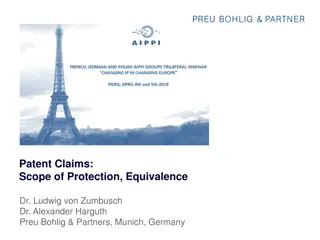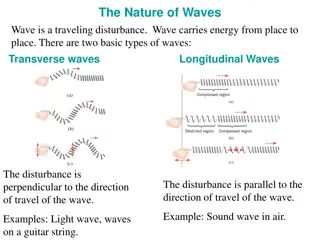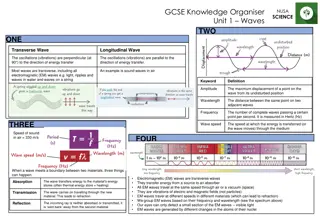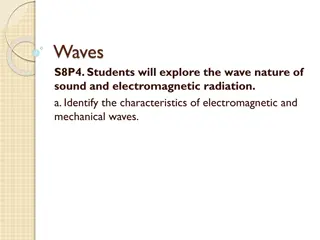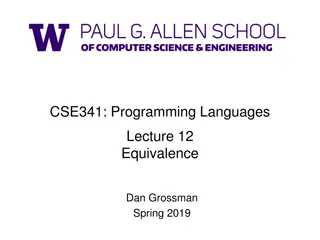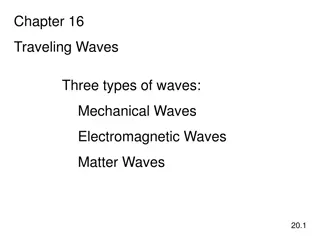Equivalence Principle in Intermediate EM Waves
Basic idea behind the equivalence principle in the context of intermediate electromagnetic waves is explored. The principle enables the replacement of actual sources with equivalent sources at the boundary of a closed surface, maintaining certain field conditions and boundary constraints. The concept is illustrated through images and explanations, emphasizing the satisfaction of Maxwell's equations and boundary conditions.
Download Presentation

Please find below an Image/Link to download the presentation.
The content on the website is provided AS IS for your information and personal use only. It may not be sold, licensed, or shared on other websites without obtaining consent from the author.If you encounter any issues during the download, it is possible that the publisher has removed the file from their server.
You are allowed to download the files provided on this website for personal or commercial use, subject to the condition that they are used lawfully. All files are the property of their respective owners.
The content on the website is provided AS IS for your information and personal use only. It may not be sold, licensed, or shared on other websites without obtaining consent from the author.
E N D
Presentation Transcript
ECE 6340 Intermediate EM Waves Fall 2016 Prof. David R. Jackson Dept. of ECE Notes 26 1
Equivalence Principle Basic idea: We can replace the actual sources in a region by equivalent sources at the boundary of a closed surface. ( ) , E H ( ) , E H a b ANT S Keep original fields E,H outside S. Put zero fields (and no sources) insideS. 2
Equivalence Principle (cont.) a = = E E a H H b = = 0 E b 0 H No sources Note: (Ea,Ha) and (Eb,Hb) both satisfy Maxwell s equations. 3
Equivalence Principle (cont.) The B.C. s on S are violated. Introduce equivalent sources on the boundary to make B.C. s valid. n Original fields a ( ) e s J a b = e n sJ H H b ( ) e s M a b Zero fields = e s n M E E 4
Equivalence Principle (cont.) Hence = e s n J H = e s n M E Equivalent sources: Outside S, these sources radiate the same fields as the original antenna, and produce zero fields inside S. S Zero fields e sJ This is justified by the uniqueness theorem: e s M Zero sources Maxwell's equations are satisfied along with boundary conditions at the interface. 5
Equivalence Principle (cont.) Note about materials: If thereare zero fieldsthroughout a region, it doesn t matter what material is placed there (or removed). ( ) , E H This object can be added e sJ r e s M Zero fields S 6
Scattering by a PEC sJ ( ) , E H Source PEC s E i E S t E = 0 i s = + E E E i s = + H H H 7
Scattering by a PEC (cont.) sJ ( ) , E H Source PEC We put zero fields and sources inside of S, and remove the PEC object. S Equivalent Sources: ( ) , E H e ( ) sJ 0,0 = = = = e s n E n 0 M E Source t , = e s n J H J e s M 0 0 s n S 8
Scattering by a PEC (cont.) Original problem: ( ) , E H Source sJ PEC S Equivalent problem: ( ) , E H sJ ( ) 0,0 Source , 0 0 S Conclusion: The conductor can be removed. 9
Scattering by a PEC (cont.) Integral equation for the unknown current ( ) , E H ( ) s J 0,0 Source , 0 0 Note: The bracket notation means field due to a source . s t i t + = 0 E E i t + = 0, E J E r S t s so i t Electric Field Integral Equation (EFIE) = E J E t s This integral equation has to be solved numerically. 10
Scattering by Dielectric Body ( ) , E H ( ) , E H Source , s E i r r E i s = + E E E i = = E incident field Note: The body is assumed to be homogeneous. s E scattered field 11
Exterior Equivalence a = = E E b = = 0 E a H H Source b 0 H , r r S Replace body by free space (The material doesn t matter in the zero-field region.) ( ) , E H + ( ) e sJ 0,0 Source , + e s 0 0 M ( ) a + = e s n 0 J H S ( ) a + = e s n 0 M E n 12
Summary for Exterior Original problem: , r r S ( ) Free-space problem: , E H ( ) + e sJ 0,0 + + = e s n J H , + e s 0 0 M + + = e s n E M S n 13
Interior Equivalence b = = 0 E a = = E E b 0 H a H H ( ) a a , E H = n n No sources or fields outside S , r r S Place dielectric material in the "dead region" (region b). ) ( ) ( + a + = = = = + e s e s = = n n n e s e s 0 J H H H J J J ) ( ) ( + + e s e s a + M M = = = = e s e s n n n 0 M E E E M 14
Interior Equivalence (cont.) ( ) 0,0 ( ) , E H + = e s e s J J , + = e s e s M M r r S , n r r When we calculate the fields from these currents, we let them radiate in an infinite dielectric medium. 15
Summary for Interior Original problem: , r r S Homogeneous- medium problem: ( ) 0,0 + e sJ ( ) , E H , + e s M r r , S r r n 16
Integral Equation The + means calculate the fields just outside the surface, radiated by the sources in free space. The means calculate the fields just inside the surface, assuming an infinite dielectric region. , r r S Recall: + i t + + + = e s e s e s e s , , E J M E E J M Boundary conditions: + = = e s e s J J t t + i t + + + + = e s e s e s e s e s e s , , H J M H H J M M M t t + i t + + + + + = e s e s e s e s , , E J M E J M E t t PMCHWT Integral Equation* Hence: + i t + + + + + = e s e s e s e s , , H J M H J M H t t * Poggio-Miller-Chang-Harrington-Wu-Tsai 17
Fields in a Half Space Sources, structures, etc. ( ) , E H Region of interest (z> 0) z Equivalence surface S (closed at infinity in the z < 0 region) ( ) Equivalent sources: , E H e sJ (0,0) = e s z J H = e s z M E e s M 18
Fields in a Half Space (cont.) Put PEC in zero-field region: ( ) , E H e sJ z PEC e s M The electric surface current on the PEC does not radiate. Note: The fields are only correct for z >0. ( ) , E H Hence, we have: z e s M PEC = e s z M E 19
Fields in a Half Space (cont.) Now use image theory: ( ) , E H ( , ) 0 0 M s Correct fields Incorrect fields = e s 2 M M z s = z 2 M E s Note: The fields are correct for z > 0. This is useful whenever the electric field on the z = 0 plane is known. 20
Fields in a Half Space: Summary ( ) , E H Sources + objects Region of interest (z> 0) z ( ) , E H ( , ) 0 0 M s Correct fields Incorrect fields z = z 2 M E s 21
Fields in a Half Space (cont.) Alternative (better when H is known on the interface): The magnetic current does not radiate on PMC, and is therefore not included. e sJ PMC z ( ) , Image theory: E H ( , ) Correct fields 0 0 sJ Incorrect fields = = e s z 2 2 J J H s 22
Example: Radiation from Waveguide y x = y E ( , ,0) E x y cos 0 a b z y x b a 23
Example (cont.) x = = e s x E z cos M E 0 Step #1 a Apply equivalence principle z The feeding waveguide was removed from the dead region that was created, and then an infinite PEC plane was introduced. PEC x = x E 2 cos M 0 s a Step #2 Apply image theory z Image theory is applied to remove the ground plane and double the magnetic surface current. Note: An alternative way of getting to step 1 is to apply B.C.s for Ms on a PEC. 24
Example (cont.) z A three-dimensional view y a b x = x E 2 cos M x 0 s a 25
Example (cont.) Step #3 Apply duality z Use the theory of Notes 22 to find the far field from this rectangular strip of electric surface current. Solve for the far field of this problem first. (This is the A problem in the notation of the duality notes.) A three-dimensional view y a x = x E 2 cos J b 0 s a x J E H M H s s 0 0 Then use: 0 0 E 26
Example (cont.) The vector array factor for the case A problem is then a b x ( ) ( ) j k x k y + dx dy = x E , 2 cos a e x y 0 a a b = = sin cos sin sin k k k k 0 x 0 y We then have, for case A, that the far field is ( ) j A r , , ~ E t ( ) ( r a e r ) ( , , ) ~ A r , 4 jkr = ( ) r 27
Example (cont.) For the original waveguide-fed aperture problem we then have a b x ( ) ( ) j k x k y + dx dy = x E , 2 cos f e x y 0 a a b = = sin cos sin sin k k k k 0 x 0 y The far field then j F r ( , , ) ~ H t ( ) r f ( , ) ~ 0 F 4 jkr e = r ~ ( ) E H ( ) r 0 r 28
Example (cont.) Performing the integration, we have a a cos k k b x 2 2 ( ) = y x E , 2 sinc b f 0 2 2 2 k a x 2 2 = = sin cos sin sin k k k k 0 x 0 y We also have ( ) ( ) ) ( ) ( ( ) ( ) = + x f x f , f t x x ( ) ( ) = cos cos + sin f x 29
Example (cont.) The far field of the waveguide-fed aperture is then: ( , , ) ~ H r j F r ( , , ) t 0 ( ~ ) E r H jkr e ( ) r f ( , ) = ~ F ( ) r 0 t t 4 r ( ) ( ) ( ) ( ) ( ) = cos cos + , sin , f f t x a a cos k = = sin cos sin sin k k k k k b x 2 2 ( ) 0 x = y , 2 sinc b f E 0 x 2 2 2 k a 0 y x 2 2 30
Example (cont.) The final result is then: a a cos k k b jkr x e 2 2 ( ) ( , , ) ~ E r y sin 2 sinc b j E 0 0 0 2 2 4 2 r k a x 2 2 a a cos k y k b jkr x e 2 2 ( ) ( , , ) ~ E r cos cos 2 sinc j E b 0 0 0 2 2 4 2 r k a x 2 2 where = = sin cos sin sin k k k k 0 x 0 y 31
Volume Equivalence Principle A radiating electric current can be replaced by a magnetic current, and vice versa. z z ( , ) E H ( , ) E H 2 2 1 1 y y iJ i M x x We wish to have the same set of radiated fields. P. E. Mayes, The equivalence of electric and magnetic sources , IEEE Trans. Antennas Propag., vol. 6, pp. 295 296, 1958. 32
Volume Equivalence Principle (Cont.) Set 1 (electric current source): = = + E j H 1 0 1 i H J j E 1 0 1 Hence ( ) ( ) = E j H 1 0 1 ( ) = + i j J j E 0 0 1 Therefore, we have ( ) = 2 0 i E k E j J 1 1 0 33
Volume Equivalence Principle (Cont.) Set 2 (magnetic current source): = = i E H j H M 2 0 2 j E 2 0 2 Hence ( ) ( ) ) = i E j H M 2 0 2 ( = i j j E M 0 0 2 Therefore, we have ( ) = 2 0 i E k E M 2 2 34
Volume Equivalence Principle (Cont.) Compare: ( ) = 2 0 i E k E j J 1 1 0 ( ) = 2 0 i E k E M 2 2 Set = i i j J M 0 Hence 1 = i i J M = E E j 1 2 0 35
Volume Equivalence Principle (Cont.) Next, examine the difference in the two Faraday laws: = = E j H 1 0 1 i E j H M 2 0 2 so ( ) ( ) = i E E j H j H M 1 2 0 1 0 2 This gives us 1 = i H H M 1 2 j 0 Hence, the two electric fields are equal everywhere, but the magnetic fields are only the same outside the source region. 36
Volume Equivalence Principle (Cont.) Summary z z y y i M iJ x x E J E M = i i 1 = i i J M 1 j H M = i i i H J M 0 j 0 37
Volume Equivalence Principle (Cont.) Apply duality on the two curl equations to get two new equations: ( ) = 2 0 i H k H j M 1 1 0 ( ) = 2 0 i H k H J 2 2 z z ( , ) E H ( , ) E H 1 1 2 2 y y i M iJ x x 38
Volume Equivalence Principle (Cont.) ( ) = 2 0 i H k H j M 1 1 0 ( ) = 2 0 i H k H J 2 2 Hence 1 = i i M J = i i H H j 1 2 0 Similarly, from duality we have = = H j E 1 0 1 + i H j E J 2 0 2 ( ) ( ) = i H H j E E J 1 2 0 1 2 39
Volume Equivalence Principle (Cont.) Summary z z y y iJ i M x x H M = i i H J 1 = i i M J j 1 E M E J = i i i J 0 j 0 40
